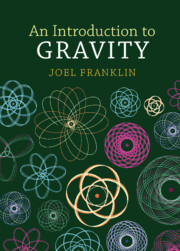Refine listing
Actions for selected content:
16933 results

An Introduction to Gravity
-
- Published online:
- 04 May 2024
- Print publication:
- 11 April 2024
-
- Textbook
- Export citation
9 - Geometry and dynamics in Yang–Mills matrix models
- from Part III - Noncommutative field theory and matrix models
-
- Book:
- Quantum Geometry, Matrix Theory, and Gravity
- Published online:
- 04 April 2024
- Print publication:
- 11 April 2024, pp 260-290
-
- Chapter
- Export citation
Appendix B - Some SO(D) group theory
-
- Book:
- Quantum Geometry, Matrix Theory, and Gravity
- Published online:
- 04 April 2024
- Print publication:
- 11 April 2024, pp 373-380
-
- Chapter
- Export citation
References and Further Reading
-
- Book:
- Quantum Geometry, Matrix Theory, and Gravity
- Published online:
- 04 April 2024
- Print publication:
- 11 April 2024, pp 389-399
-
- Chapter
- Export citation
6 - Gravitational Sources
-
- Book:
- An Introduction to Gravity
- Published online:
- 04 May 2024
- Print publication:
- 11 April 2024, pp 211-246
-
- Chapter
- Export citation
Part II - Quantum spaces and geometry
-
- Book:
- Quantum Geometry, Matrix Theory, and Gravity
- Published online:
- 04 April 2024
- Print publication:
- 11 April 2024, pp 29-30
-
- Chapter
- Export citation
3 - Quantization of symplectic manifolds
- from Part II - Quantum spaces and geometry
-
- Book:
- Quantum Geometry, Matrix Theory, and Gravity
- Published online:
- 04 April 2024
- Print publication:
- 11 April 2024, pp 31-75
-
- Chapter
- Export citation
Appendix E - Functions on coadjoint orbits
-
- Book:
- Quantum Geometry, Matrix Theory, and Gravity
- Published online:
- 04 April 2024
- Print publication:
- 11 April 2024, pp 384-385
-
- Chapter
- Export citation
3 - The Riemann Tensor and Einstein’s Equation
-
- Book:
- An Introduction to Gravity
- Published online:
- 04 May 2024
- Print publication:
- 11 April 2024, pp 102-135
-
- Chapter
- Export citation
13 - Matrix quantum mechanics and the BFSS model
- from Part IV - Matrix theory and gravity
-
- Book:
- Quantum Geometry, Matrix Theory, and Gravity
- Published online:
- 04 April 2024
- Print publication:
- 11 April 2024, pp 363-371
-
- Chapter
- Export citation
Dedication
-
- Book:
- Quantum Geometry, Matrix Theory, and Gravity
- Published online:
- 04 April 2024
- Print publication:
- 11 April 2024, pp v-vi
-
- Chapter
- Export citation
Appendix D - Some integrals
-
- Book:
- Quantum Geometry, Matrix Theory, and Gravity
- Published online:
- 04 April 2024
- Print publication:
- 11 April 2024, pp 383-383
-
- Chapter
- Export citation
12 - Gravity as a quantum effect on quantum spacetime
- from Part IV - Matrix theory and gravity
-
- Book:
- Quantum Geometry, Matrix Theory, and Gravity
- Published online:
- 04 April 2024
- Print publication:
- 11 April 2024, pp 342-362
-
- Chapter
- Export citation
7 - Yang–Mills matrix models and quantum spaces
- from Part III - Noncommutative field theory and matrix models
-
- Book:
- Quantum Geometry, Matrix Theory, and Gravity
- Published online:
- 04 April 2024
- Print publication:
- 11 April 2024, pp 223-251
-
- Chapter
- Export citation
Acknowledgments
-
- Book:
- An Introduction to Gravity
- Published online:
- 04 May 2024
- Print publication:
- 11 April 2024, pp xv-xv
-
- Chapter
- Export citation
11 - Matrix theory: Maximally supersymmetric matrix models
- from Part IV - Matrix theory and gravity
-
- Book:
- Quantum Geometry, Matrix Theory, and Gravity
- Published online:
- 04 April 2024
- Print publication:
- 11 April 2024, pp 319-341
-
- Chapter
- Export citation
Copyright page
-
- Book:
- An Introduction to Gravity
- Published online:
- 04 May 2024
- Print publication:
- 11 April 2024, pp iv-iv
-
- Chapter
- Export citation
Appendix F - Glossary and notations
-
- Book:
- Quantum Geometry, Matrix Theory, and Gravity
- Published online:
- 04 April 2024
- Print publication:
- 11 April 2024, pp 386-388
-
- Chapter
- Export citation
5 - Covariant quantum spaces
- from Part II - Quantum spaces and geometry
-
- Book:
- Quantum Geometry, Matrix Theory, and Gravity
- Published online:
- 04 April 2024
- Print publication:
- 11 April 2024, pp 118-174
-
- Chapter
- Export citation
6 - Noncommutative field theory
- from Part III - Noncommutative field theory and matrix models
-
- Book:
- Quantum Geometry, Matrix Theory, and Gravity
- Published online:
- 04 April 2024
- Print publication:
- 11 April 2024, pp 177-222
-
- Chapter
- Export citation
